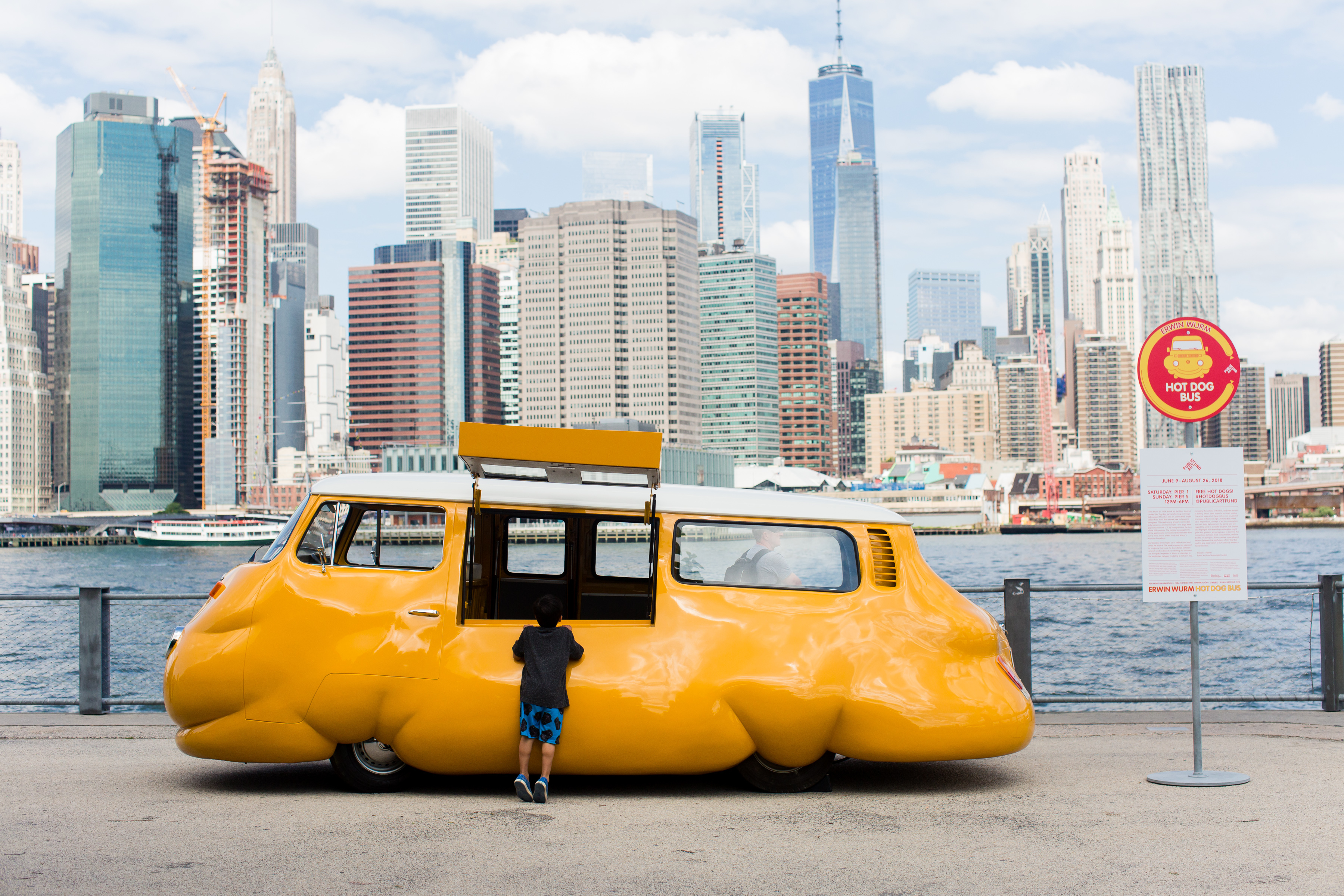
During his nearly 30-year career, Erwin Wurm has explored the boundaries between the human body and sculpture. He often invites spectators to take on a participatory role and become a part of his practice. Public Art Fund has brought Wurm’s latest experiential initiative to Brooklyn Bridge Park in the form of Hot Dog Bus, an overstuffed mobile sculpture that will serve free hot dogs to park-goers throughout the summer. Here, Wurm discusses the consumeristic undertones behind his playful VW bus.
You’ve created large-scale sculptures of cucumbers, UFOs, and distorted houses among other attention-grabbing structures. What led you to put a focus on hot dogs with your latest work? Hot Dog Bus belongs to the series Fat Cars. It is made from a VW bus created and designed in the ‘60s and ‘70s. A couple of years ago, I had a show at the Kunstmuseum in Wolfsburg, Germany, which is the same town that is home to VW’s headquarters and its largest manufacturing plant in the world. I became interested in creating something for the show with one of VW’s cars and decided on the van because it is such an icon. VW had purchased a sausage company to feed curry sausage to its 120,000 workers and I became interested in the idea of taking the car and selling sausages outside of the museum during my show. It was a big success.
The hot dog is such a basic and iconic thing here in the states. I wanted to address this in a work of art.
What is the significance of having it in this location? How do you want it to interact with its surroundings? Interaction is an important part of every work that I create. I liked the idea that the piece will be shown outside in the public space. I strongly believe that even the best piece of art – if nobody can see it, it has no importance. I always want my work to be easily accessed and to give people the opportunity to interact with it.
Hot Dog Bus is a participatory piece of art. I am connecting my work with the notion of sculpture and social issues. I define the eating of a hot dog as a sculptural work because it works with volume – if you change volume you change content. When we eat, we engage with volumes and sculpt ourselves, becoming walking sculptures for a period of time. That is present with the sausage. With the bus, I brought these two components together. The technical structure of the car and biological structure of the body.
It’s very exciting to have it in Brooklyn Bridge Park. The Manhattan skyline in the background creates a beautiful background for the piece itself. It’s also a great spot for the because many people and tourists spend time in the park.
How does this piece relate to your Austrian background? The Frankfurter sausage is an Austrian icon. These sausages are representative of European food, specifically cheap and accessible food. The hot dog is its equivalent in the states.
How has your practice evolved from the 1980s to now? Have some of your interests and explorations stayed the same? In my career, I’ve made two objects from daily life: the car and the house. I found these subjects interesting because as humans, we define ourselves by our property and the things we own. Our homes and are cars especially are the icons in our lives. They address how we define ourselves, our wealth, and our coming up. In a way, it’s a tool for identification. I’ve always wanted to engage with and ask questions around that idea, as well as questions of consumer society–labor, advancement, sexuality, the idea of youth–things like that.
The idea of consumption plays a role in Hot Dog Bus as well as many of your other pieces. Can you explain your concern with society’s consumption and why you see this piece as a reflection on that? It’s not the consumption itself as much as our planets effect from it. When you travel, you see how devastated our world is. Consumerism and our level of consumption has destroyed our planet. We continue to consume not realizing it will kill us and have unimaginable consequences for our grandchildren and future generations.
What do you hope viewers walk away from Hot Dog Bus with? When you have a piece of art and the artist is offering something to the public, they can either accept it and engage in it or not. With Hot Dog Bus, if they accept the hot dog, in a way they accept the piece of art. If they eat the hot dog they become a part of the sculptural process. For me this is an interesting game.
For more from Wurm, check out Public Art Fund’s new video:










 in your life?
in your life?

